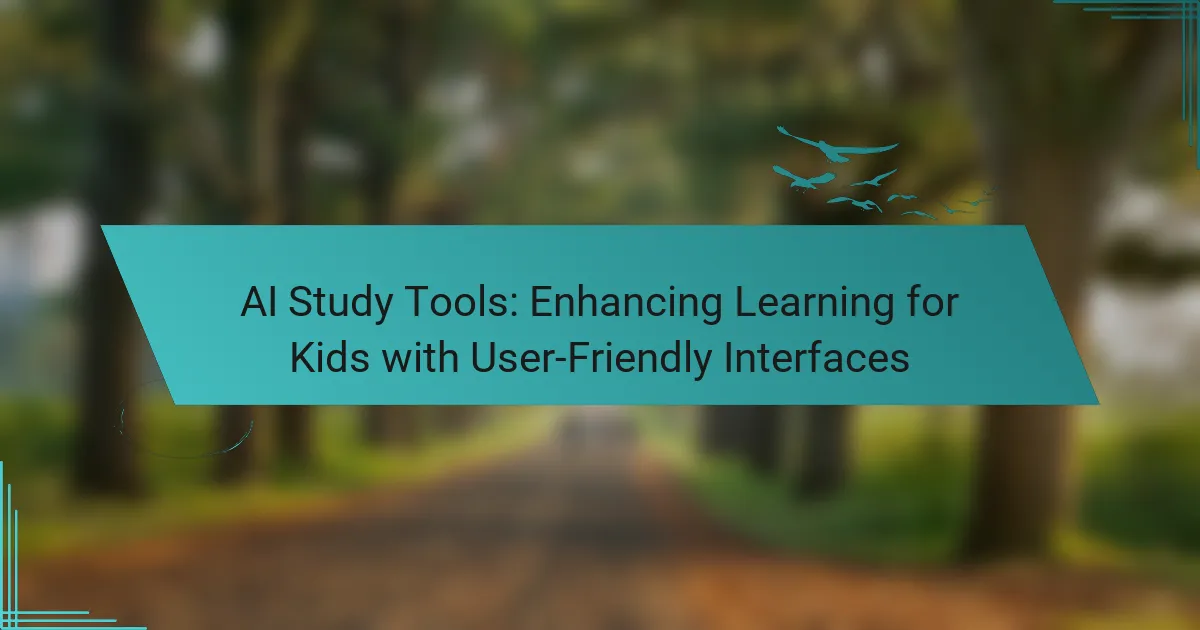AI study tools are revolutionizing the way children learn by offering personalized educational experiences tailored to their unique needs. With user-friendly interfaces and engaging content, platforms like Khan Academy Kids and Duolingo ABC make learning interactive and enjoyable, ensuring that kids stay motivated and focused on their studies.

How Can AI Study Tools Improve Learning for Kids?
AI study tools can significantly enhance learning for kids by providing tailored educational experiences that cater to individual needs. These tools leverage advanced algorithms to adapt content, making learning more engaging and effective.
Personalized Learning Experiences
Personalized learning experiences allow children to progress at their own pace, focusing on areas where they need the most help. AI tools analyze a child’s performance and preferences, adjusting the difficulty and type of content accordingly.
For instance, a student struggling with math might receive additional practice problems and interactive tutorials, while another excelling in reading could be offered advanced literature. This targeted approach fosters a deeper understanding and retention of material.
Engaging User Interfaces
Engaging user interfaces are crucial for maintaining children’s interest in learning. AI study tools often feature colorful graphics, interactive elements, and gamified experiences that make education feel less like a chore and more like a fun activity.
For example, platforms might use animations or rewards systems to encourage progress, which can motivate kids to spend more time learning. A well-designed interface can significantly impact a child’s willingness to engage with educational content.
Instant Feedback Mechanisms
Instant feedback mechanisms provide immediate responses to a child’s answers, helping them understand mistakes and learn from them right away. This real-time interaction helps reinforce concepts and correct misunderstandings before they become ingrained.
For example, if a child answers a question incorrectly, the AI tool can offer hints or explanations, guiding them toward the correct answer. This immediate support is essential for effective learning and boosts confidence in their abilities.
Adaptive Learning Paths
Adaptive learning paths adjust the curriculum based on a child’s evolving needs and performance. As students progress, AI tools can shift focus to new topics or revisit challenging areas, ensuring a comprehensive understanding of the subject matter.
This flexibility allows for a more dynamic learning journey, where students are not stuck in a one-size-fits-all approach. Parents and educators can track progress and make informed decisions about further learning strategies, optimizing educational outcomes.

Which AI Study Tools Are Best for Kids?
Some of the best AI study tools for kids include Khan Academy Kids, Duolingo ABC, Prodigy Math, and Quizlet. These platforms offer engaging, user-friendly interfaces designed to enhance learning through interactive content and personalized experiences.
Khan Academy Kids
Khan Academy Kids is a free educational app that provides a wide range of subjects for young learners. It features interactive activities, videos, and games that adapt to each child’s learning pace, making it suitable for preschool through early elementary school.
Parents can track progress through the app, ensuring that children are mastering key concepts. The content is aligned with educational standards, making it a reliable resource for foundational skills in reading, math, and social-emotional learning.
Duolingo ABC
Duolingo ABC is an app focused on teaching young children the basics of reading and writing in a fun, engaging way. It uses gamified lessons that include interactive stories and exercises, which help maintain children’s interest while they learn.
This tool is particularly effective for early literacy, with a curriculum designed for kids aged 3 to 6. The app is free and offers a user-friendly interface that encourages kids to practice daily, fostering consistent learning habits.
Prodigy Math
Prodigy Math is an engaging platform that turns math practice into an adventure game. Children can create their own characters and embark on quests that require solving math problems to progress, making learning enjoyable.
The platform adapts to each child’s skill level, providing personalized questions that align with their curriculum. Prodigy Math is free to use, but a premium version offers additional features, which can be considered based on the child’s needs.
Quizlet
Quizlet is a versatile study tool that allows kids to learn through flashcards, games, and quizzes. It supports a wide range of subjects and enables users to create their own study sets or use existing ones shared by others.
This platform is particularly useful for older children, as it helps reinforce knowledge through repetition and active recall. Quizlet offers both free and premium subscriptions, with the latter providing advanced features like offline access and enhanced study modes.

What Features Should Parents Look for in AI Study Tools?
Parents should prioritize user-friendly interfaces, diverse content, effective progress tracking, and robust safety measures when selecting AI study tools for their children. These features ensure that the tools are not only engaging but also effective in enhancing learning outcomes.
User-Friendly Design
A user-friendly design is crucial for AI study tools as it allows children to navigate the platform easily. Look for interfaces that are intuitive, with clear icons and simple navigation paths. Tools that offer customization options, such as adjustable font sizes and color themes, can also enhance usability.
Consider tools that provide tutorials or guided tours to help children familiarize themselves with the features. This can minimize frustration and encourage independent learning.
Content Variety
AI study tools should offer a wide range of content types, including videos, quizzes, and interactive exercises. This variety keeps children engaged and caters to different learning styles, whether they prefer visual, auditory, or kinesthetic learning methods.
Check if the tool covers multiple subjects and grade levels, allowing for a comprehensive learning experience. Tools that update their content regularly can also provide fresh material to maintain interest.
Progress Tracking
Effective progress tracking features help parents and children monitor learning advancements over time. Look for tools that provide detailed reports on performance, including strengths and areas needing improvement.
Some tools offer gamification elements, such as badges or rewards for completing tasks, which can motivate children to engage more with their studies. Ensure that the tracking system is easy to understand and provides actionable insights.
Safety and Privacy Controls
Safety and privacy controls are essential in AI study tools to protect children’s personal information. Parents should seek tools that comply with relevant regulations, such as COPPA in the United States, which safeguards children’s online privacy.
Look for features like parental controls, content filtering, and transparent data usage policies. Tools that allow parents to monitor interactions and limit access to certain features can provide additional peace of mind.

How Do AI Study Tools Support Different Learning Styles?
AI study tools cater to various learning styles by offering personalized experiences that enhance comprehension and retention. These tools utilize adaptive technology to align with visual, auditory, and kinesthetic preferences, making learning more effective for each child.
Visual Learning Support
Visual learners benefit from AI study tools that incorporate graphics, charts, and videos to convey information. These tools often use color coding and visual cues to highlight key concepts, making it easier for students to grasp complex ideas. For example, interactive diagrams can simplify subjects like science or math, allowing learners to visualize relationships and processes.
To maximize the effectiveness of visual learning support, parents should encourage the use of tools that offer customizable visual elements. This can help children create a personalized learning environment that resonates with their preferences.
Auditory Learning Features
Auditory learners thrive with AI study tools that provide spoken instructions, podcasts, and interactive discussions. These features allow students to absorb information through listening, which can enhance understanding and recall. For instance, tools that read text aloud can help auditory learners engage with reading materials more effectively.
To support auditory learning, parents should seek tools that allow for repetition and varied audio formats. This can help reinforce concepts and cater to different auditory preferences, such as music or spoken word.
Kinesthetic Learning Activities
Kinesthetic learners excel with AI study tools that incorporate hands-on activities and interactive simulations. These tools often include games and practical exercises that require physical engagement, making learning more dynamic. For example, virtual labs can allow students to conduct experiments in a safe, controlled environment.
To enhance kinesthetic learning, parents should look for tools that encourage movement and active participation. Incorporating physical activities, such as building models or using manipulatives, can further solidify concepts and keep learners engaged.

What Are the Benefits of Using AI Study Tools in the Classroom?
AI study tools offer numerous advantages in educational settings, including personalized learning experiences, efficient feedback mechanisms, and enhanced resource accessibility. These tools can adapt to individual student needs, making learning more effective and engaging.
Enhanced Engagement
AI study tools significantly boost student engagement by providing interactive and adaptive learning experiences. These tools often incorporate gamification elements, which can make studying more enjoyable and motivate students to participate actively in their learning process.
For instance, platforms that use AI can analyze a student’s progress and adjust the difficulty of tasks accordingly, keeping them challenged but not overwhelmed. This tailored approach helps maintain interest and encourages continuous improvement.
To maximize engagement, educators should select AI tools that align with their curriculum and offer features that appeal to their students’ interests. Regularly updating content and incorporating diverse formats, such as videos and quizzes, can further enhance student involvement.
